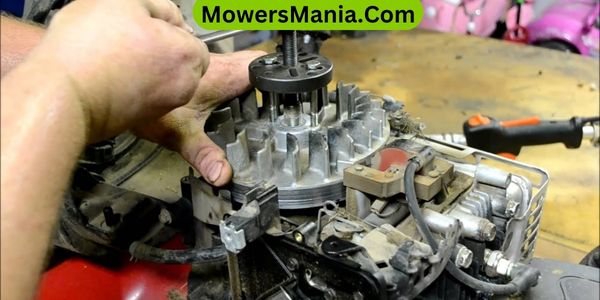If your lawn mower engine is sputtering or refusing to start, you can easily repair it yourself. With a few basic tools and some simple troubleshooting, you can have your engine running smoothly again in no time.
From cleaning the carburetor to checking and changing the spark plug, this guide will walk you through the steps to get your lawn mower engine back in working order.

Don’t worry, it’s easier than you think! Let’s get started.
Lawn Mower Engine Troubleshooting
To troubleshoot a lawn mower engine, begin by checking the spark plug. Start by disconnecting the spark plug wire and removing the spark plug with a socket wrench.
Inspect the spark plug for any signs of damage, such as cracks or carbon deposits. If the spark plug is dirty or damaged, replace it with a new one.
Next, check the fuel supply. Ensure that there’s fresh gasoline in the tank and that the fuel line isn’t clogged. If the fuel is old or contaminated, drain the tank and refill it with fresh fuel. Additionally, clean or replace the fuel filter if necessary.
After checking the fuel supply, inspect the air filter. A dirty or clogged air filter can restrict airflow to the engine, affecting its performance. Clean or replace the air filter to ensure proper air intake.
Lastly, if the engine still won’t start, consider checking the carburetor for any blockages or adjusting the carburetor settings.
Cleaning the Carburetor
You can start cleaning the carburetor by first removing the air filter cover and the air filter. This will allow you to access the carburetor for cleaning and maintenance.
Once the air filter is removed, you can proceed with the following steps to clean the carburetor:
| Step | Instructions | Tools Needed | Time Required |
|---|---|---|---|
| 1 | Locate the carburetor | Screwdriver | 5 minutes |
| 2 | Disconnect the fuel line | Pliers | 3 minutes |
| 3 | Remove the carburetor | Socket wrench | 10 minutes |
| 4 | Clean the carburetor thoroughly | Carburetor cleaner | 15 minutes |
Ensure that you work in a well-ventilated area and follow all safety precautions when using carburetor cleaner. After cleaning the carburetor, reassemble the lawn mower by following the steps in reverse order.
Cleaning the carburetor will help improve the performance and efficiency of your lawn mower engine, ultimately leading to a smoother operation.
Replacing the Air Filter

After cleaning the carburetor, it’s essential to inspect the air filter for any dirt or debris that may impede proper airflow and replace it if necessary. The air filter plays a crucial role in preventing dirt and debris from entering the engine, ensuring it runs smoothly.
Here’s how to replace the air filter:
- Locate the Air Filter: Find the air filter housing, which is usually a plastic or metal box near the carburetor. It’s secured with screws or clips.
- Remove the Old Filter: Open the housing and carefully take out the old air filter. Check for any signs of damage or excessive dirt accumulation.
- Install the New Filter: Insert the new air filter into the housing, ensuring it fits snugly. Close the housing and secure it properly.
Regularly inspecting and replacing the air filter as needed is essential for maintaining optimal engine performance. A clean air filter allows for proper airflow, which is vital for the combustion process.
By following these steps, you can ensure that your lawn mower’s engine receives a consistent flow of clean air, extending its lifespan.
Checking and Changing the Spark Plug
Inspecting the spark plug for wear or fouling is crucial for the ignition process in your lawn mower engine. Start by disconnecting the spark plug wire and using a spark plug wrench to carefully remove the plug.
Examine the electrode at the end of the spark plug. If it’s covered in black carbon deposits or damaged, it’s time to replace it.
When purchasing a new spark plug, ensure that it’s the correct type and gap size for your lawn mower model. Use a gap tool to set the distance between the center electrode and the ground electrode to the manufacturer’s specifications.
Carefully thread the new spark plug into the engine by hand to avoid cross-threading. Once it’s snug, use the spark plug wrench to tighten it securely.
Regularly inspecting and changing the spark plug is essential for maintaining a healthy ignition system in your lawn mower engine.
A well-functioning spark plug ensures efficient fuel combustion and smooth engine operation. By following these simple steps, you can keep your lawn mower engine running smoothly and extend its lifespan.
Adjusting the Fuel System

To ensure optimal engine performance, regularly check and adjust the fuel system of your lawn mower. Proper maintenance of the fuel system is essential for the efficient operation of your lawn mower engine.
Here are some key steps to help you adjust the fuel system:
- Inspect the Fuel Lines: Check for any cracks, leaks, or signs of wear in the fuel lines. Replace any damaged fuel lines to prevent fuel leakage and ensure proper fuel flow to the engine.
- Clean the Carburetor: Over time, the carburetor can become clogged with dirt, debris, and old fuel, leading to engine performance issues. Remove the carburetor and clean it thoroughly to ensure smooth fuel delivery and combustion.
- Adjust the Fuel Mixture: If your lawn mower engine is running too rich or too lean, it can lead to performance problems. Use the adjustment screws on the carburetor to fine-tune the fuel mixture for optimal engine operation.
Frequently Asked Questions [FAQs]
How Often Should I Sharpen the Lawn Mower Blades?
You should sharpen the lawn mower blades at least once a year. Regular maintenance will ensure a clean, precise cut and prevent damage to your grass. Remember to always follow safety guidelines when handling sharp equipment.
What Type of Oil Should I Use for My Lawn Mower Engine?
You should use SAE 30 for warm weather and SAE 10W-30 for varying temperatures in your lawn mower engine. Check the manufacturer’s recommendations for the specific oil type and don’t forget to change it regularly.
Is It Necessary to Change the Oil Filter in a Lawn Mower Engine?
Yes, it’s necessary to change the oil filter in a lawn mower engine. It helps remove contaminants and debris from the oil, ensuring the engine runs smoothly. Regular filter changes also extend the engine’s lifespan.
How Can I Prevent Grass Clippings From Clogging the Engine?
To prevent grass clippings from clogging the engine, regularly clean the mower deck and undercarriage. Use a power washer or scraper to remove buildup. Also, consider using a grass catcher to minimize clippings from reaching the engine.
Can I Use Ethanol Fuel in My Lawn Mower Engine?
You can use ethanol fuel in your lawn mower engine, but it’s important to be cautious. Ethanol can cause corrosion and damage if left in the engine for extended periods. Regularly maintaining and using the mower will minimize these issues.
Conclusion
Now that you’ve troubleshooted and repaired your lawn mower engine, your lawn mower should be running smoothly again.
Remember to regularly clean the carburetor, replace the air filter, and check the spark plug to prevent future issues.
With these simple maintenance tasks, you can keep your lawn mower in great shape for years to come.
Happy mowing!



